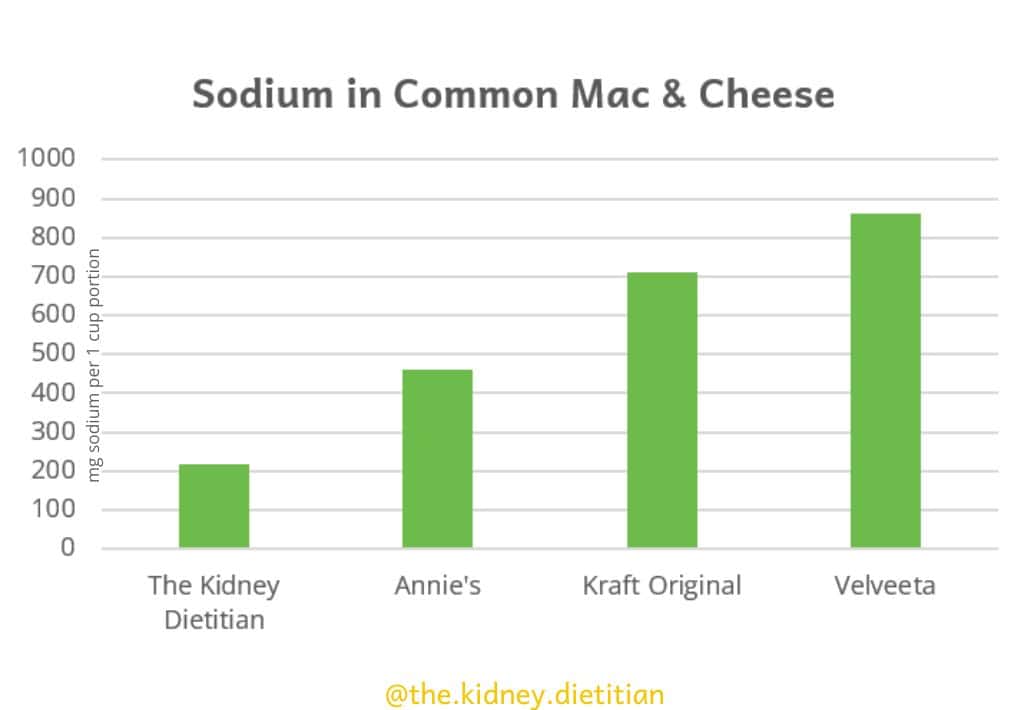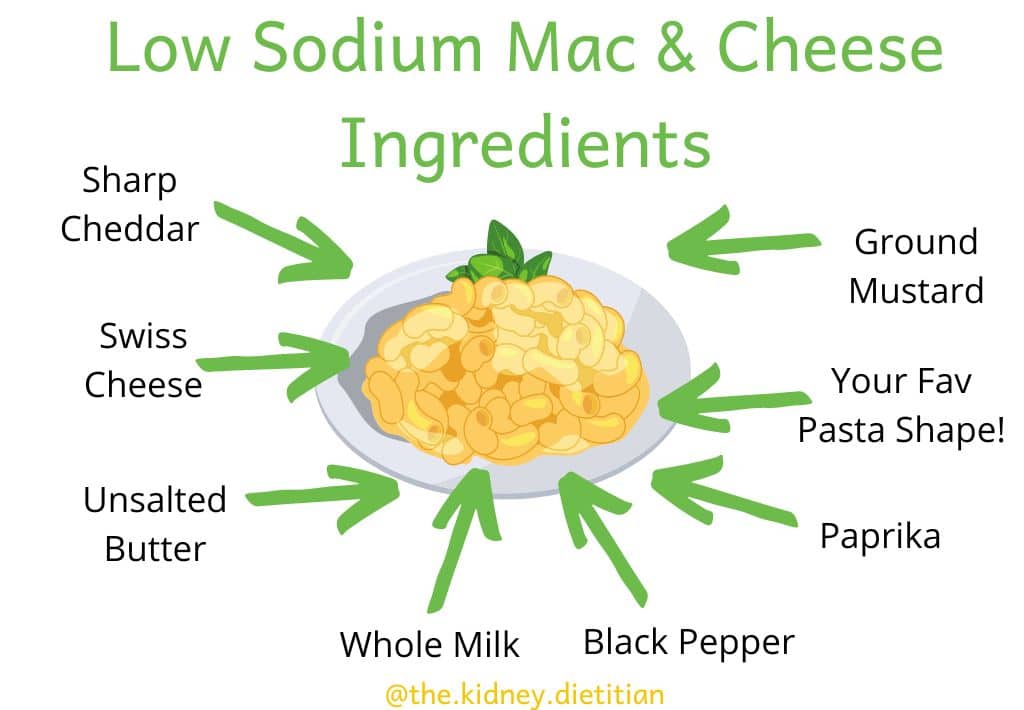This article was written by dietetic student Rebecca Webb & reviewed by Melanie Betz MS, RD, CSR, FAND.
Who doesn’t love mac and cheese? This low sodium mac and cheese is the perfect way to enjoy mac and cheese, while still getting to cut down on the salt!
Table of Contents
Sodium and Health
Why is it important to eat low sodium? Too much sodium can cause kidney problems, including stones or kidney disease. Eating too much salt can also lead to other health problems like high blood pressure, heart disease, and stroke (1) (2). Too much sodium is also linked to kidney stones and kidney disease.
Most of the sodium we eat comes from processed foods. These include packaged foods from the grocery store, cured meats, and other fast-food items. When food gets processed, salt often is added to make the food last longer. Although food preservation is important, eating a lot of these foods typically means you are eating a lot of sodium. The boxed mac & cheese in your pantry is a perfect example of a highly processed food.
Replacing typical high salt mac & cheese with this homemade, low sodium option is a great way to keep sodium down!
Sodium in Mac and Cheese
Ever thought about how much salt is in mac and cheese? There may be a lot more than you realize. Most common Mac & Cheese brands fall into the “high-sodium foods” category, containing about 500-850 mg of salt per 1 cup.
The Dietary Guidelines for Americans recommends having no more than 2,300 mg of sodium a day (2). This means that just 1 cup of Mac & Cheese has 20-35% of the daily recommendation. Have more than a cup, and you could easily reach 1,000 mg of salt in one sitting or more. That’s over 40% of your sodium recommendation for the day!

Our low sodium mac and cheese contains about 30-50% of the sodium in popular mac & cheese brands.
Here is the amount of sodium in 1 cup of some common mac & cheese brands:.
- Annie’s: 460 mg sodium
- Kraft Original: 710 mg sodium
- Velveeta – 860 mg sodium
Sodium in Cheese
The main source of sodium in mac and cheese is the cheese itself! Popular cheeses such as Cheddar, American, and Parmesan may contain anywhere from 175-550 mg per 1 oz serving. This can really add up!
However, there are cheeses that are lower sodium. Some examples include ricotta cheese, cottage cheese, and swiss cheese. Swapping higher sodium cheese with these can help keep sodium down! Reducing the total amount of cheese can help too.
In this recipe, we used a combination of swiss and cheddar cheese. This combination helped to control the sodium, while still getting that traditional mac and cheese taste. Additionally, we used a smaller amount of higher sodium cheddar cheese than most mac and cheese recipes do.
Lower Sodium Ingredients in Low Sodium Mac and Cheese
Aside from cheese, there are other sources of sodium that are frequently used in Mac & Cheese.

Butter
Butter is available salted or unsalted. Salted butter has about 90 mg of salt per tbsp, whereas unsalted butter has very little sodium. We used unsalted butter in this low sodium mac & cheese recipe as another way to reduce sodium.
Salt
Extra salt is a common ingredient found in many mac and cheese recipes. We limited the added salt, and uses spices and herbs to add delicious flavor instead.
Breadcrumbs
Breadcrumbs are often used in mac and cheese recipes. Unfortunately, most seasoned breadcrumbs contain lots of salt! Most seasoned breadcrumbs have 250-550 mg of salt per serving.
This recipe calls for plain breadcrumbs such as Progresso Panko Plain Breadcrumbs*, which only have about 50 mg salt per serving. Instead of salt, we added herbs and spices to the breadcrumbs as a replacement.
Panko breadcrumbs* are another low sodium choice and help make the topping extra crispy!
Herbs & Spices
This recipe uses spices and herbs instead of salt. Spices and herbs is a great way to maintain a tasty flavor and keep the sodium content low.
When you make this recipe, use as much or as little of the spices and herbs as you like. Everyone has different flavor preferences! You can even experiment with adding your own favorite herbs and spices instead of the ingredients we used.
Low Sodium Mac and Cheese Boxes at the Store
We searched and searched for a low sodium box of mac and cheese. The best option we could find was Annie’s Reduced Sodium Cheddar Macaroni & Cheese Dinner with Organic Pasta* If you want a quicker mac & cheese option, this option is for you!
It does have more sodium than our sodium mac & cheese recipe at 400mg sodium per cup. But this is less than other options.
Note that Annie’s Reduced Sodium Cheddar Macaroni & Cheese has phosphate additives, which should be avoided for people with chronic kidney disease.
Try Using Cheese Powder
For another quick low sodium mac and cheese option, you could make your own with cheese powder.
Cheese Powders are higher in salt, but they allow you to control how much sodium is in the recipe. Many cheese powder brands contain around 250-300 mg of sodium per tablespoon. So, one tablespoon of cheese powder to your serving of pasta along with other low sodium ingredients such as unsalted butter and milk could work!
Here are some cheese powder brands to try:
- Hoosier Hill Farm White Cheddar Cheese Powder* (contains phosphate additives)- 280 mg/tbsp
- Nutricost Pantry White Cheddar Cheese Powder*- 260 mg/tbsp
- It’s Just – Cheddar Cheese Powder* (contains phosphate additives) or It’s Just – White Cheddar Cheese Powder* (contains phosphate additives) – 270 mg/tbsp
Build a Low Sodium Mac and Cheese Meal
Even low sodium mac and cheese can become HIGH sodium if you eat a lot of it. To feel full and keep your meal low sodium, fill up on very low sodium sides.
My favorite sides dishes to mac and cheese are fruit or a simple side salad with oil & vinegar dressing.
Happy Eating!
Low Sodium Mac and Cheese
Ingredients
- 2 cups sharp cheddar cheese grated
- 2 cups Swiss cheese grated
- 3 tbsp unsalted butter divided
- 2 tbsp all purpose flour
- 2 cups whole milk
- 1/2 tsp ground nutmeg
- 2 1/2 tsp ground black pepper divided
- 2 tsp paprika divided
- 1 tsp ground mustard
- 1 pound Cavatappi (or your favorite pasta)
- 1/2 cup plain breadcrumbs
- 1 tsp dried oregano
- 2 tablespoon fresh parsley chopped
Instructions
- Preheat oven to 375°F.
- Make Pasta: bring a large pot of water to boil. Once boiling, add pasta and cook until al dente/slightly firm. Do not over-boil. Strain pasta and set aside.
- In another large pot, begin to form a roux by melting 2 tbsp unsalted butter over medium-low heat. Once melted, sprinkle in flour and begin to stir constantly in a circular motion with a wooden spoon or small rubber spatula. Continue stirring for about 5 minutes, or until thickened roux has formed. Take the pot off of the heat. Whisk in 2 cups of milk, adding gradually.
- Add nutmeg, 1 ½ tsp black pepper, 1 ½ tsp paprika and ground mustard.
- Slowly add sharp cheddar and swiss cheese into the mixture, stirring as you go. Optional: add an additional pasta water if needed to achieve desired sauce consistency.
- Add pasta to sauce mixture and stir until evenly combined. Pour mixture into a casserole dish.
- Prepare toasted herbed breadcrumbs: In a small bowl, mix plain breadcrumbs with oregano, 1 tsp parsley, remaining ½ tsp paprika, and remaining 1 tsp black pepper. In a small skillet, melt a tbsp of butter over very low heat. Once melted, add breadcrumb mixture and stir over heat until slightly toasted, about 1-2 minutes.
- Sprinkle bread crumbs over mac & cheese, and put in the oven.
- Cook for about 30 minutes or until the top is golden-brown.

